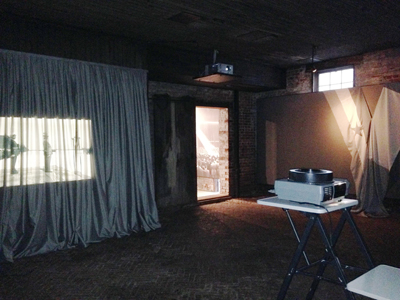In his “Requiem for a Nun,” William Faulkner famously wrote, “The past is never dead. It’s not even passed.” Photographer Vesna Pavlović approached the image archive in the Museum of Yugoslav History in Belgrade with a similar spirit while gathering material for her exhibition “Fabrics of Socialism,” which is currently installed in Inman Park’s mysterious but cozy Whitespace Gallery.
What makes the enduring presence of the past particularly complicated for Pavlović is that she is attempting to navigate not only large-scale political history but also her own personal history in the exhibition. A native of Serbia – which formerly constituted part of the Socialist Federal Republic of Yugoslavia – Pavlović returned to her home to investigate the national record of life in post-war Yugoslavia and to challenge the boundaries of memory, personal as well as collective, and the limits of photographic representation.
A juxtaposition of individual experience against the sweeping forces of national and global history creates the poignant, beautiful and quite disturbing drama at the heart of “Fabrics of Socialism.” Pavlović’s photographs of the towers of reels of film contained in the Museum of Yugoslav History achieve a paradoxical effect. Though these archives ostensibly form a record of history, history itself is destroying them, rendering the physical components of that record increasingly less accessible.
In addition to these photographs, the exhibition includes two multimedia elements. One of these is a slideshow presentation of photographs from Yugoslav President Josip Broz Tito’s travels around the world. The second is a looping video of Yugoslavian state television’s broadcast of the 1979 Relay of Youth, an annual event held in honor of Tito’s birthday. For this event, various youth groups participated in a relay race requiring them to carry a baton from Tito’s hometown of Kumrovec to Belgrade’s Partizan Stadium. Upon the baton’s arrival in the stadium, there is an enormous celebration with a degree of pageantry familiar to many viewers only in Olympic opening and closing ceremonies.
Nine-year-old Pavlović participated in this ceremony and was able to identify herself in the video among the seemingly countless exuberant youth present to honor Tito and celebrate the future of Yugoslavia. This video and photographic slideshow possess some of the qualities of a home video: one is easily lulled into fascination with the spectacle of the Relay of Youth or entranced by the mechanical whir of the slideshow projector.
Simultaneously, however, an underlying awareness of the sinister character of it all never quite departs from the viewer. Though photographs and video would aspire to impart objective representation of the past, almost no answers are offered here, especially in regard to the culpability of those depicted – and perhaps even those doing the depicting. As the members of the Youth Army assemble into the shape of the Soviet hammer and sickle, one cannot help but wonder how many of these boys are still alive, where they live now and what journey carried them from the Partizan Stadium of 1979 to their present location. Bodies are equally, if not more, vulnerable than spools of film to the violence of history, and it is concern for these bodies, living or dead, that transcends representation.
– By Logan Lockner
Photo courtesy of Whitespace Gallery
The Emory Wheel was founded in 1919 and is currently the only independent, student-run newspaper of Emory University. The Wheel publishes weekly on Wednesdays during the academic year, except during University holidays and scheduled publication intermissions.
The Wheel is financially and editorially independent from the University. All of its content is generated by the Wheel’s more than 100 student staff members and contributing writers, and its printing costs are covered by profits from self-generated advertising sales.






